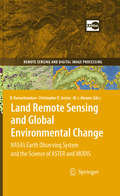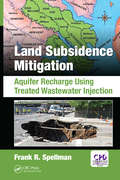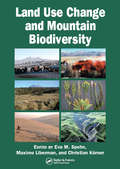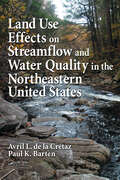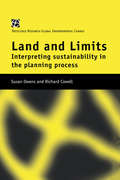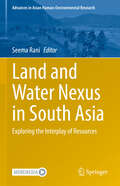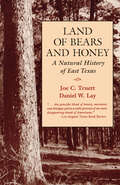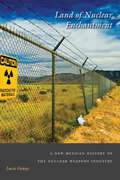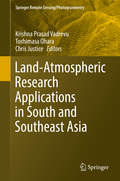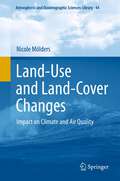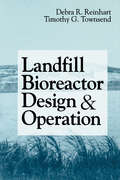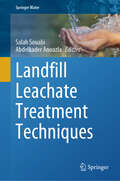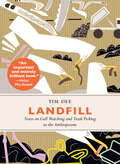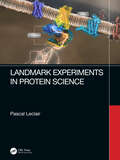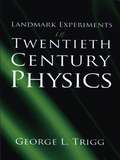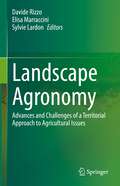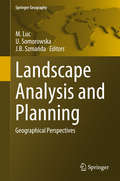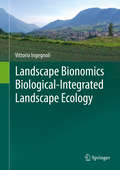- Table View
- List View
Land Remote Sensing and Global Environmental Change
by Michael J. Abrams Christopher O. Justice Bhaskar RamachandranLand Remote Sensing and Global Environmental Change: The Science of ASTER and MODIS is an edited compendium of contributions dealing with ASTER and MODIS satellite sensors aboard NASA's Terra and Aqua platforms launched as part of the Earth Observing System fleet in 1999 and 2002 respectively. This volume is divided into six sections. The first three sections provide insights into the history, philosophy, and evolution of the EOS, ASTER and MODIS instrument designs and calibration mechanisms, and the data systems components used to manage and provide the science data and derived products. The latter three sections exclusively deal with ASTER and MODIS data products and their applications, and the future of these two classes of remotely sensed observations.
Land Subsidence Mitigation: Aquifer Recharge Using Treated Wastewater Injection
by Frank R. SpellmanThis book examines the process of injecting treated wastewater into wells to replenish aquifers, and thereby slow the process of land subsidence, and help to mitigate coastal flooding. It explains how up to fifty percent of sea-level rise may be due to land subsidence, and up to fifty percent of land subsidence may be due to aquifer compaction. The concepts covered discuss replenishing aquifers with clean water to reduce nutrient discharges into out-falled waterways; providing a sustainable supply of groundwater; reducing the rate of land subsidence; and protecting the groundwater from saltwater intrusion. Practical case studies from Virginia and California will be included.
Land Use Change and Mountain Biodiversity
by Eva M. Spehn Máximo Liberman Christian KornerPart of the worldwide biodiversity program DIVERSITAS, the Global Mountain Biodiversity Assessment (GMBA) assesses the biological richness of high-elevation biota. GMBA's focus includes the uppermost forest regions or their substitute rangeland vegetation, the treeline ecotone, and the alpine and nival belts. Providing more than description, the GM
Land Use Effects on Streamflow and Water Quality in the Northeastern United States
by Avril L. de la Cretaz Paul K. BartenFilling a long-standing need for a desk reference that synthesizes current research, Land Use Effects on Streamflow and Water Quality in the Northeastern United States reviews and discusses the impact of forest management, agriculture, and urbanization. The book provides a gateway to the diverse scientific literature that is urgently needed
Land Use and the Carbon Cycle
by Daniel G. Brown Derek T. Robinson Nancy H. F. French Bradley C. ReedAs governments and institutions work to ameliorate the effects of anthropogenic CO2 emissions on global climate, there is an increasing need to understand how land-use and land-cover change is coupled to the carbon cycle, and how land management can be used to mitigate their effects. This book brings an interdisciplinary team of fifty-eight international researchers to share their novel approaches, concepts, theories and knowledge on land use and the carbon cycle. It discusses contemporary theories and approaches combined with state-of-the-art technologies. The central theme is that land use and land management are tightly integrated with the carbon cycle and it is necessary to study these processes as a single natural-human system to improve carbon accounting and mitigate climate change. The book is an invaluable resource for advanced students, researchers, land-use planners and policy makers in natural resources, geography, forestry, agricultural science, ecology, atmospheric science and environmental economics.
Land and Limits: Interpreting Sustainability in the Planning Process (Rtpi Library Ser.)
by Richard Cowell Susan OwensIn a new and critical analysis, this book explores the impact of an influential idea - sustainable development - on the institutions and practices governing use of land. It examines the paradox that in spite of increasing attention to sustainability, land use conflict is as ubiquitous and intense as ever.
Land and Water Nexus in South Asia: Exploring the Interplay of Resources (Advances in Asian Human-Environmental Research)
by Seema RaniThis book aims to unravel the intricate relationship between land and water resources and delve into their interdependencies, synergies, and challenges. As the world grapples with pressing issues such as water scarcity, land degradation, and climate change, understanding the complex dynamics and interplay between these two critical resources has become more crucial than ever. This comprehensive volume brings together multidisciplinary perspectives from leading experts in the field, offering an integrated approach to studying the land-water nexus. The book provides readers with a clear understanding of how land and water interact and delves into key topics such as land use change and its impacts on water resources, water management in agricultural landscapes, land-water interactions in aquatic ecosystems, urbanization and water resource management, and climate change's influence on the land-water nexus. Moreover, the book investigates integrated governance frameworks, policy considerations, and sustainable development approaches that are essential for effective land and water resource management. It also sheds light on future perspectives and research frontiers, envisioning innovative solutions to address emerging challenges in this field. By synthesizing current knowledge, showcasing case studies, and presenting cutting-edge research, this book provides a valuable resource for researchers, policymakers, and professionals working in water resource management, environmental science, agriculture, urban planning, and sustainable development. The book's holistic approach encourages readers to envision sustainable pathways that balance the needs of both land and water, fostering a resilient and harmonious future for our planet.
Land of Bears and Honey: A Natural History of East Texas
by Joe C. Truett Daniel W. LayThis award-winning &“gem&” of a conservation classic tells the story of the land, wildlife, and ecology of East Texas (Quarterly Review of Biology).Winner of the Ottis Lock Endowment Award from the East Texas Historical Association; the Texas Literary Festival Award for Nonfiction from the Southwestern Booksellers Association & Dallas Times Herald; and the Annual Publication Award, Texas Chapter of the Wildlife Society As hickory groves and fox squirrels began to vanish from the East Texas landscape in the second half of the twentieth century, two biologists who specialized in wildlife and endangered species began work on Land of Bears and Honey. Their purpose was not only to eulogize what was lost, but to encourage us to save what we still can. The result is an &“elegant chronicle of the natural history of a once-rich area [that] will appeal strongly to birders, ecologists, to anyone who enjoys the outdoors&” (Publishers Weekly). &“This deceptively slender volume is three things: a how-to-book, an aesthetic feast and a moral tale.&” —Dallas Morning News &“To compare the style and content of this little book to that of the late Aldo Leopold is indeed high praise, yet the reviewer finds this comparison valid.&” —Quarterly Review of Biology &“In Land of Bears and Honey, East Texans have their own regional Walden, written with keen historical perspectives, literary style, and deep respect for the land.&” —East Texas Historical Journal &“This graceful blend of history, narrative and dialogue paints a noble portrait of one more disappearing chunk of Americana.&” —Los Angeles Times Book Review
Land of Bears and Honey: A Natural History of East Texas
by Joe C. Truett Daniel W. LayThis award-winning &“gem&” of a conservation classic tells the story of the land, wildlife, and ecology of East Texas (Quarterly Review of Biology).Winner of the Ottis Lock Endowment Award from the East Texas Historical Association; the Texas Literary Festival Award for Nonfiction from the Southwestern Booksellers Association & Dallas Times Herald; and the Annual Publication Award, Texas Chapter of the Wildlife Society As hickory groves and fox squirrels began to vanish from the East Texas landscape in the second half of the twentieth century, two biologists who specialized in wildlife and endangered species began work on Land of Bears and Honey. Their purpose was not only to eulogize what was lost, but to encourage us to save what we still can. The result is an &“elegant chronicle of the natural history of a once-rich area [that] will appeal strongly to birders, ecologists, to anyone who enjoys the outdoors&” (Publishers Weekly). &“This deceptively slender volume is three things: a how-to-book, an aesthetic feast and a moral tale.&” —Dallas Morning News &“To compare the style and content of this little book to that of the late Aldo Leopold is indeed high praise, yet the reviewer finds this comparison valid.&” —Quarterly Review of Biology &“In Land of Bears and Honey, East Texans have their own regional Walden, written with keen historical perspectives, literary style, and deep respect for the land.&” —East Texas Historical Journal &“This graceful blend of history, narrative and dialogue paints a noble portrait of one more disappearing chunk of Americana.&” —Los Angeles Times Book Review
Land of Nuclear Enchantment: A New Mexican History of the Nuclear Weapons Industry
by Lucie GenayIn this thoughtful social history of New Mexico&’s nuclear industry, Lucie Genay traces the scientific colonization of the state in the twentieth century from the points of view of the local people. Genay focuses on personal experiences in order to give a sense of the upheaval that accompanied the rise of the nuclear era. She gives voice to the Hispanics and Native Americans of the Jémez Plateau, the blue-collar workers of Los Alamos, the miners and residents of the Grants Uranium Belt, and the ranchers and farmers who were affected by the federal appropriation of land in White Sands Missile Range and whose lives were upended by the Trinity test and the US government&’s reluctance to address the &“collateral damage&” of the work at the Range. Genay reveals the far-reaching implications for the residents as New Mexico acquired a new identity from its embrace of nuclear science.
Land of Wondrous Cold: The Race to Discover Antarctica and Unlock the Secrets of Its Ice
by Gillen D’Arcy WoodA gripping history of the polar continent, from the great discoveries of the nineteenth century to modern scientific breakthroughsAntarctica, the ice kingdom hosting the South Pole, looms large in the human imagination. The secrets of this vast frozen desert have long tempted explorers, but its brutal climate and glacial shores notoriously resist human intrusion. Land of Wondrous Cold tells a gripping story of the pioneering nineteenth-century voyages, when British, French, and American commanders raced to penetrate Antarctica’s glacial rim for unknown lands beyond. These intrepid Victorian explorers—James Ross, Dumont D’Urville, and Charles Wilkes—laid the foundation for our current understanding of Terra Australis Incognita.Today, the white continent poses new challenges, as scientists race to uncover Earth’s climate history, which is recorded in the south polar ice and ocean floor, and to monitor the increasing instability of the Antarctic ice cap, which threatens to inundate coastal cities worldwide. Interweaving the breakthrough research of the modern Ocean Drilling Program with the dramatic discovery tales of their Victorian forerunners, Gillen D’Arcy Wood describes Antarctica’s role in a planetary drama of plate tectonics, climate change, and species evolution stretching back more than thirty million years. An original, multifaceted portrait of the polar continent emerges, illuminating our profound connection to Antarctica in its past, present, and future incarnations.A deep-time history of monumental scale, Land of Wondrous Cold brings the remotest of worlds within close reach—an Antarctica vital to both planetary history and human fortunes.
Land, Food And Rural Development In North Africa
by M. Riad El-GhonemyThis study of rural development in six North African nations addresses the issues surrounding poverty and landlessness. Providing an Islamic perspective on policy-making, the author describes the influence of Islam on development in these countries, and stresses the Islamic religious and moral revival as a major factor in policy-making toward reduc
Land-Atmospheric Research Applications in South and Southeast Asia (Springer Remote Sensing/photogrammetry Ser.)
by Krishna Prasad Vadrevu Toshimasa Ohara Chris JusticeThis edited volume sheds new light on the impact of rapid Land Use/Cover Changes (LU/CC) on greenhouse gases (GHG’s) and aerosol emissions in South and Southeast Asia. Several countries in South/Southeast Asia have the highest population growth rates in the world, which is the main cause for LU/CC. Conversion of dense forests to agricultural areas and then to residential and urban areas is most commonly observed in South/Southeast Asian countries with a significant release of GHG’s and aerosols. The book showcases several case studies on the use of remote sensing and geospatial technologies to quantify biomass burning and air pollution impacts, aerosol pollution, LU/CC, and impacts on ecosystem services. The book also includes articles on regional initiatives in research, capacity building, and training. The authors of this book are international experts in the field, and their contributions highlight significant drivers and impacts of air pollution in South/Southeast Asia. Readers will discover the latest tools and techniques, in particular, the use of satellite remote sensing and geospatial technologies for quantifying GHG’s, aerosols and pollution episodes in this region.
Land-Use and Land-Cover Changes
by Nicole MöldersWildfires, changing glaciers, deforestation, open-pit mining, increasing demands for food and bio-fuel production and the growth of megacities change our landscape. The book comprehensively reviews the current knowledge on how natural and anthropogenic land-use/cover changes affect weather, air quality and climate worldwide and explains how these changes may trigger further land-use/cover changes. It discusses how anthropogenic land-use/cover changes have affected local and regional climate and air quality since the settlement of America and the industrialisation. It addresses the topic how long-range transport of pollutants and dust of devasted areas as well as teleconnections may cause changes far away from the areas where the land-use/cover changes occurred, for which land-use/cover change may become an international issue similar to CO2. It also discusses relations to global change and future societal and scientific challenges related to land-use/cover changes.
Landau Fermi Liquids and Beyond
by V. TripathiThis book consolidates the older and more recent concepts on weakly-interacting fermions where traditional many-body techniques are adequate. Targeting primarily the advanced undergraduates and graduates, the author has included plenty of examples and problems from contemporary topics of research.
Landfill Bioreactor Design & Operation
by Timothy G. TownsendUsing biotechnology to help control landfill processes can mitigate costs, shorten the time needed to process solid waste, and ease the typical ecological damage to the land being used. This first-of-its-kind book provides regulators, designers, landfill owners, and operators with information that supports the utility of landfill bioreactors and provides design and operating criteria essential for the successful application of this technology. It pulls together laboratory, pilot, and full-scale experiences into one concise guide to designing and running municipal landfills as bioreactors. Landfill Bioreactor Design and Operation covers the history and background of landfill technology, research studies of actual bioreactor landfills, expected leachate and gas yields, specific design criteria, operation guidelines, and reuse of landfill sites to avoid having to establish new sites. For anyone looking for an alternative to large, wasteful landfill sites, this book provides a practical alternative to the problem.
Landfill Leachate Treatment Techniques (Springer Water)
by Salah Souabi Abdelkader AnouzlaThis book is a ready reckoner of recent information regarding the impact of leachate landfills, leachate treatment, and heavy metals on a single platform. The amount of waste is constantly growing due to population growth and the evolution of socioeconomic activities. Burying this waste produces leachate, a contaminated effluent created during the decomposition of organic waste and containing harmful substances like heavy metals, polyphenols, volatile organic compounds, and microorganisms. These effluents emit unpleasant odors associated with ammonium ions. These discharges significantly impact the environment. As a result, the master's and doctoral academics, researchers, and students will be able to comprehend the most recent developments in municipal solid waste landfill operations, supporting their research. This book inspires readers on how to deal with environmental pollution problems due to leachate contamination in freshwater and agricultural soils using a variety of technologies.
Landfill: Notes on Gull Watching and Trash Picking in the Anthropocene
by Tim Dee"There&’s love and death here, fear, fascination, hope, and the breaking of the world. Dee has written an absolute triumph.&”―Helen Macdonald, author of H Is for HawkOver the past hundred years, gulls have been brought ashore by modernity. They now live not only on the coasts but in our slipstream following trawlers, barges, and garbage trucks. They are more our contemporaries than most birds, living their wild lives among us in towns and cities. In many ways they live as we do, walking the built-up world and grabbing a bite where they can. Yet this disturbs us. We&’ve started fearing gulls for getting good at being among us. We see them as scavengers, not entrepreneurs; ocean-going aliens, not refugees. They are too big for the world they have entered. Their story is our story too. Landfill is the original and compelling story of how in the Anthropocene we have learned about the natural world, named and catalogued it, and then colonized it, planted it, or filled it with our junk. While most other birds have gone in the opposite direction, hiding away from us, some vanishing forever, gulls continue to tell us how the wild can share our world. For these reasons Landfill is the nature book for our times, groundbreaking and genre-bending. Without nostalgia or eulogy, it kicks beneath the littered surface of the things to discover stranger truths. "In his delightful jaunt through gull taxonomy, behavior, and lore, Tim Dee casts his feathered protagonists as indomitable heroes of the Anthropocene―thriving in our cities, colonizing our culture, and repurposing our trash as treasure. Next time a gull snatches your fries, you&’ll find yourself not cursing a petty thief, but admiring one of our planet&’s grittiest, savviest survivors.&”―Ben Goldfarb, author of Eager and Crossings
Landmark Experiments in Protein Science
by Pascal LeclairProteins are the workhorses of cells, performing most of the important functions which allow cells to use nutrients and grow, communicate among each other, and importantly, die if aberrant behavior is detected. How were proteins discovered? What is their role in cells? How do dysfunctional proteins give rise to cancers? Landmark Experiments in Protein Science explores the manner in which the inner workings of cells were elucidated, with a special emphasis on the role of proteins. Experiments are discussed in a manner as to understand what questions were being asked that prompted the experiments and what technical challenges were faced in the process; and results are presented and discussed using primary data and graphs. Key Features Describes landmark experiments in cell biology and biochemistry. Discusses the "How" and "Why" of historically important experiments. Includes primary, original data and graphs. Emphasizes biological techniques, that help understand how many of the experiments performed were possible. Documents, chronologically, how each result fed into the next experiments.
Landmark Experiments in Twentieth-Century Physics
by George L. TriggPhysics is very much an experimental science, but too often, students at the undergraduate level are not exposed to the reality of experimental physics - i.e., what was done in a given experiment, why it was done, the background of physics against which the experiment was carried out and the changes in theory and knowledge that resulted. In this hook, the author helps to remedy the situation by presenting a variety of "landmark" experiments that have brought about significant alterations in our ideas about some aspect of nature. Among these scientific milestones are discoveries about the wave nature of x-rays, isotopes, the meaning of atomic number, superconductivity, fine structure in the spectrum of helium, the transistor, the neutrino, the maser and laser, higher symmetry for elementary particles and other seminal discoveries.Over 120 illustrations enhance the text, often reproductions of those published with the original experimental results. The result is a fascinating survey ideal as a supplement for intermediate or advanced undergraduate courses in experimental physics, history of science, radio and radar astronomy, crystallography, high energy physics and other disciplines.
Landscape Agronomy: Advances and Challenges of a Territorial Approach to Agricultural Issues
by Davide Rizzo Elisa Marraccini Sylvie LardonThe landscape is widely identified as a relevant target both by integrative policies and across the disciplines dealing with resource management and territorial planning. Landscape agronomy promotes a greater involvement of agricultural sciences into this arena by increasing the attention on the dynamics relating the farming practices to the natural resources and the temporal and spatial patterns of land covers. This book covers the background that improved the transdisciplinary interface of agronomy with spatially-explicit disciplines like landscape ecology and geography both in research and in training programs, in addition to some experiences of participative landscape management. On these bases, the state of art on cutting-edge data availability and methodological issues is used to select and discuss some worldwide case studies. This selection of research topic examples underpins the concluding discussions about challenges ahead. Researchers as well as policy and decision makers are the main target of this book that seeks to provide a toolbox of concepts, examples and ideas to improve the understanding of agricultural landscapes. Agricultural activities manage the greatest share of land surface on Earth with fast-paced changes compared to any other human land use. With this book we aim at providing a stronger interface between agricultural science and landscape design processes.
Landscape Analysis and Planning
by M. Luc U. Somorowska J. B. SzmańdaThis book presents recent advances in landscape analysis and landscape planning based on selected studies conducted in different parts of Europe. Included are methodological problems and case studies presented and discussed during scientific sessions organized by the Commission of Landscape Analysis and Landscape Planning of the International Geographical Union (IGU) within the framework of the IGU Regional Conference in Kraków, Poland, August 18-22, 2014. The subject of landscape analysis and landscape planning has been of interest to geographers since the beginning of the twentieth century. This relatively new area of study, which focuses on the landscape resource patches and spatial interconnections, was first introduced as landscape ecology (Landschaftsoekologie) by Carl Troll, one of the twentieth century's most influential physical geographers. Today, landscape studies involve adopting a holistic view of geographic environments and are closely connected to rapidly developing ecosystem, sustainable landscape and ecosystem services approaches. Modern techniques employing Geographical Information Systems are used to support spatial landscape analyses.
Landscape Bionomics Biological-Integrated Landscape Ecology
by Vittorio Ingegnoli"Landscape Bionomics," or "Bio-integrated Landscape Ecology," radically transforms the main principles of traditional Landscape Ecology by recognizing the landscape as a living entity rather than merely the spatial distribution of species and communities on the territory, often analysed in separate themes (water, species, pollution, etc. ). To be more exact, the landscape is identified as the "life organization integrating a set of plants, animals and human communities and its system of natural, semi-natural, and human cultural ecosystems in a certain spatial configuration. " This new perspective inevitably leads to significant changes in how to assess and manage the environment. This book represents the culmination of an endeavor begun by the author, with the support of Richard Forman and Zev Naveh, more than a dozen years ago. It builds on the author's previous successful publication, Landscape Ecology, A Widening Foundation, by addressing a range of additional topics and discussing the new theoretical and methodological concepts that have emerged during the past decade of research. Particular attention is paid to the fact that interventions in the landscape can be made with the best intentions yet cause serious damage! Against this background, the author explains the need to study "landscape units" by applying methods comparable to those used in clinical diagnosis - hence ecologists can be viewed as the "physicians" of ecological systems.
